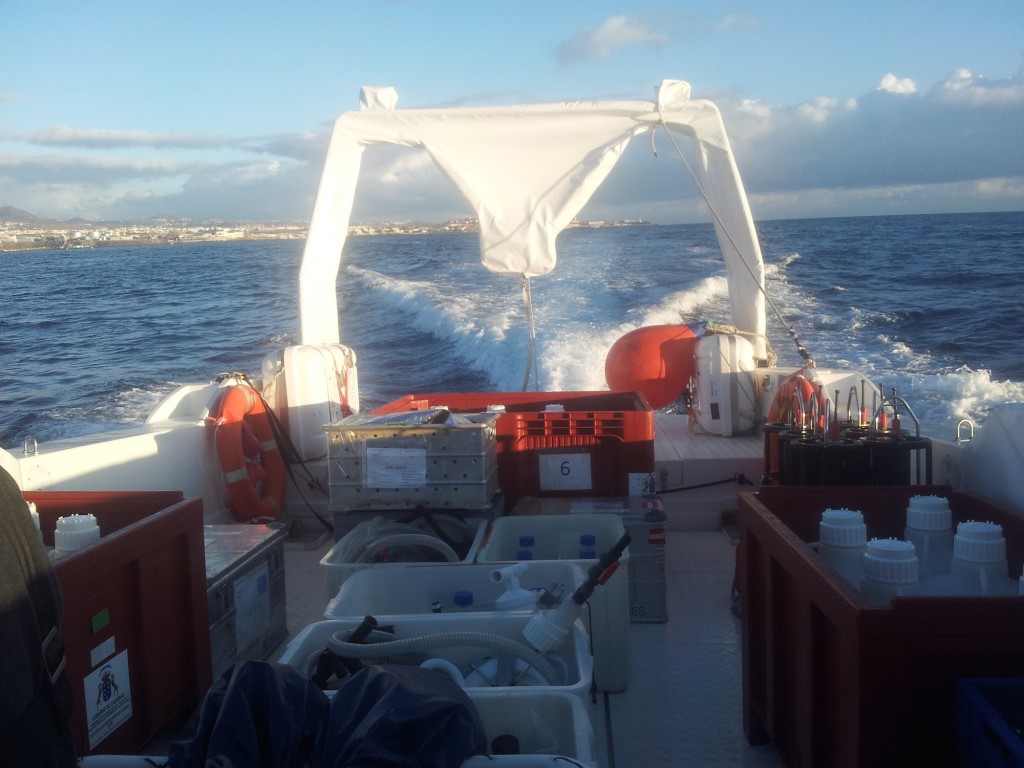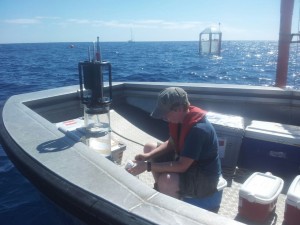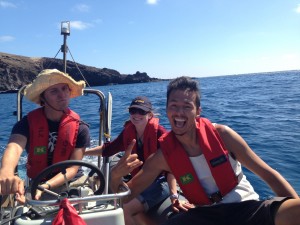[deutsche Version unten]
A normal sampling day starts at 7:30am just before the sun rises over Gran Canaria. The sampling team packs all equipment needed into the KOSMOS bus to transport it to the harbour just around the corner. The equipment comprises integrated water
samplers for gas samples, pumps to sample non gas samples, a bunch of different sampling bottles, a CTD (device to measure conductivity, temperature and density of the water inside the mesocosms) and the Kiel Vision (an optical device which will be explained in a following blog). At the harbour, the nice boat crew of „Plocan 1“ greets and helps us loading the boat. The captain Javier and his colleague Besay bring all of our equipment and us fast and safe to Gando Bay, the military bay where our mesos are deployed. At Gando Bay the sampling team splits up into small groups and conducts the sampling with our faithful boat
companions: Rita, Wassermann and C5. The following tasks have to be fulfilled: 1) Sampling of sediment traps, 2) CTD, 3) Sampling Meso water by pumping, 4) sampling Meso water with integrated water samplers and 5) Kiel vision. Conducting all the tasks just mentioned can take 3 hours when weather conditions are excellent (flat sea, no currents and wind) and sampling volumes needed for the day are low but also can take up to 5 hours. From my point of view, sampling at the mesocosms is a huge fun factor. Balancing my time in the lab with bumpy return rides on “Plocan 1” after a successful sampling is the icing on the cake. But returning to the harbour does not mean we are finished for the day. It’s when the hard work really begins. Equipment and especially full, heavy sampling bottles need to be transported back to Plocan as quickly as possible. Here, team work is all that counts; everyone is needed for carrying and splitting up the samples in order to accelerate everyone’s sample processing in the lab. As soon as possible, everyone gathers their samples and crawls back into their labs/caves with their treasures. This fun but also tiring day takes place every second day and provides us with lots of data to be taken back home.
Alice
________
Ein normaler Probennahmetag beginnt um 7:30 Uhr, kurz bevor die Sonne über Gran Canaria aufgeht. Das Probennahme-Team packt alles an Equipment, das für den Tag gebraucht wird, in den KOSMOS-Bus und bringt diese zum Hafen von Taliarte. Das Equipment umfasst Wasserschöpfer, Pumpen, verschiedenste Probengefäße, eine CTD (Gerät, welches Leitfähigkeit, Temperatur und Dichte in den Mesokosmen misst) und die Kiel Vision (ein optisches Instrument, welches in den nächsten Blogs beschrieben wird). Im Hafen empfängt uns die Mannschaft von “Plocan 1” und hilft uns das Boot zu beladen. Der Kapitän Javier und sein Kollege Besay bringen uns und unser Equipment schnell und sicher nach Gando Bay, die Militärbucht, in der die Mesokosmen verankert liegen. Dort teilt sich das Probennahme-Team in kleinere Gruppen auf und beprobt die Mesos mit Hilfe unserer treuen Boot-Begleiter: Rita, Wassermann und C5.
Folgende Aufgaben müssen erledigt werden: 1) Probenentnahme an der Sedimentfalle, 2) CTD, 3) Wasserprobennahme mit Pumpe, 4) Wasserprobennahme mit integriertem Wasserschöpfer und 5) Kiel vision. Die Probenentnahme kann 3 Stunden dauern, wenn das Wetter mitspielt (flache See, keine Strömungen und Wind) und das Probenvolumen gering ist, aber auch bis zu 5 Stunden. Meiner Meinung nach ist das Beproben der Mesokosmen ein großer “fun factor” und ein schöner Ausgleich zur Laborarbeit. Zudem ist eine wellige Rückfahrt, nach einer erfolgreichen Entnahme, das Sahnehäubchen des Tages.
Aber die Rückkehr in den Hafen bedeutet nicht, dass die Arbeit getan ist, sondern der harte Teile des Tages erst beginnt. Das Equipment und vor allem die vollen und schweren Probenflaschen müssen so schnell wie möglich zu Plocan gebracht werden. Teamarbeit ist dabei sehr wichtig! Alle werden zum tragen, aufteilen der Proben und aufräumen benötigt, um die weitere Probenverarbeitung für jeden zu beschleunigen. Schnell sucht sich jeder seine Proben zusammen und kriecht mit den neu erworbenen Schätzen zurück in sein/e Labor/Höhle. Dieses schöne, aber auch sehr anstrengende Prozedere findet jeden zweiten Tag statt und versorgt uns mit vielen Daten, die wir mit nach Hause nehmen können.
Alice


